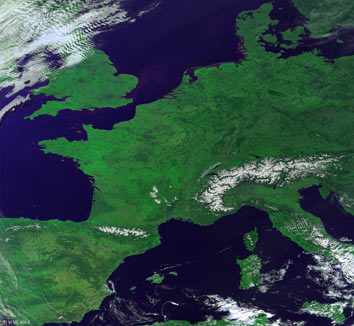Create a free profile to get unlimited access to exclusive videos, sweepstakes, and more!
Green Europe

This may be a little early for St. Patrick’s Day, but that’s OK: Europe isn’t really going green. At least, not this green.
This astonishing image is from the European Space Agency Proba-V satellite, a small Earth-observing sat that monitors vegetation (that’s what the V is for in its name!) across the entire planet. This image is actually a composite of blue, red, near-infrared (just outside the color range our eyes can detect, where plants are highly reflective), and mid-infrared, so the colors aren’t what you’d really see if you were in space looking down.
I love the look of it. It was taken just yesterday, March 9, 2015, when it happened to be a nearly cloudless day across Europe. What clouds you can see are lovely long-wavelength gravity wave ripples, usually caused by wind blowing over some sort of obstacle. The air goes up, cools, and water condenses forming clouds; then the air sinks again and clears. This creates long, parallel ripples that can go for hundreds of kilometers both across the waves and transversely. I’ll have another fun post about this kind of cloud here on the blog soon.
This sort of image is more than just jaw-droppingly gorgeous; it’s also very useful. It can be used to map changes in vegetation over time, as well as water use, agricultural monitoring, and food resource allocation.
Take another look, too. See the white streaks that aren’t clouds? Those mark mountain ranges, still snow-capped in the early spring. The Pyrenees wall off the border between Spain and France, while the huge curl of the Alps separates Italy from the other countries, running through Switzerland and Austria, delineating the southern border of Germany. How do you think that affected history? What wars were planned, won, lost, because those mountains barred passage to some strategically needed regions when the most advanced weaponry tech humans had were bows and arrows? How was our society today sculpted by happenstances of geography?
All that is spelled out in green and white, easy to see. I think images like this—especially with the borders unmarked—would make for an excellent inquiry-driven history classroom exercise.
We shape our world, and our world shapes us. We just need to see it … and with our exploration of space, we can.


























